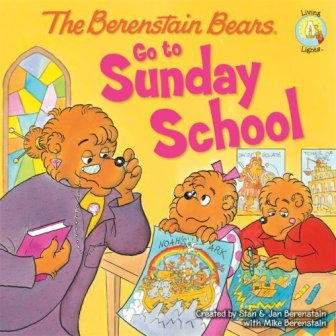The Berenstain Bears have found Jesus — some examples of recent titles starring the furry forest family include The Berenstain Bears Go To Sunday School and The Berenstain Bears Show God’s Love.  So much for my vague — and I wasn’t alone — childhood sense that they were secular Jews, if anything, all this time. (This story made headlines this week due to a New Yorker piece, though The Friendly Atheist observed the evangelical shift in 2008.)
So much for my vague — and I wasn’t alone — childhood sense that they were secular Jews, if anything, all this time. (This story made headlines this week due to a New Yorker piece, though The Friendly Atheist observed the evangelical shift in 2008.)
As USA Today religion reporter Cathy Lynn Grossman explains:
Technically, how it happened is that the Berenstains shifted publishers, winding up at HarperCollins, which owns Zonderkidz’s parent company Zondervan. Michael Berenstain, who took over illustrations after Stan’s death, cut the deal in 2008, telling the Zondervan blog that the new 12-book line was an answered prayer for Christian parents who “appreciate the values-based themes of our books. By dealing with religion through the fun and laughter of the Berenstain Bears, we hope to nurture these families in their goal of raising children secure in their faith.”
Actually, the bears are espousing values in parallel universes. The general market will still get the bears’ values, bare of explicitly Christian language and imagery, through HarperCollins.
And in other Imaginationland news: The Simpsons are “Presbylutheran,” not Catholic (sorry, Vatican).
For what it’s worth, my childhood ghost stands corrected on the Berenstain=Jewish assumption: According to Wikipedia, The Berenstain Bears’ Christmas Tree was published in 1980, followed by The Berenstain Bears Meet Santa Bear in 1984. I guess I had only seen the books that came after that, but before 1998’s The Berenstain Bears’ Easter Surprise. (Presumably, the “surprise” wasn’t that Bear Country is in the Bible Belt?)
Now that I’m dusting off my old favorites and building up a children’s book library again, I’ll take a closer look at some of these other ursine characters. Both Winnie-the-Pooh and Paddington Bear are British, so the odds are in the Anglican Communion’s favor, but who knows — especially with the latter’s murky origins in “Darkest Peru?” As for the other animal protagonists, I’m hesitant to speculate about Curious George and Babar, given their colonialist subtexts…
What do you think? Share your thoughts in the Comments section below.
*Click here to subscribe to Belief Beat and click here to follow Belief Beat on Twitter.

